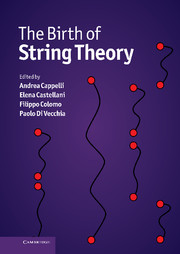Book contents
- Frontmatter
- Contents
- List of contributors
- Photographs of contributors
- Preface
- Abbreviations and acronyms
- Part I Overview
- EARLY STRING THEORY
- Part II The prehistory: the analytic S-matrix
- 5 Introduction to Part II
- 6 Particle theory in the Sixties: from current algebra to the Veneziano amplitude
- 7 The path to the Veneziano model
- 8 Two-component duality and strings
- 9 Note on the prehistory of string theory
- Part III The Dual Resonance Model
- Part IV The string
- TOWARDS MODERN STRING THEORY
- Part V Beyond the bosonic string
- Part VI The superstring
- Part VII Preparing the string renaissance
- Appendix A Theoretical tools of the Sixties
- Appendix B The Veneziano amplitude
- Appendix C From the string action to the Dual Resonance Model
- Appendix D World-sheet and target-space supersymmetry
- Appendix E The field theory limit
- Index
9 - Note on the prehistory of string theory
from Part II - The prehistory: the analytic S-matrix
Published online by Cambridge University Press: 05 May 2012
- Frontmatter
- Contents
- List of contributors
- Photographs of contributors
- Preface
- Abbreviations and acronyms
- Part I Overview
- EARLY STRING THEORY
- Part II The prehistory: the analytic S-matrix
- 5 Introduction to Part II
- 6 Particle theory in the Sixties: from current algebra to the Veneziano amplitude
- 7 The path to the Veneziano model
- 8 Two-component duality and strings
- 9 Note on the prehistory of string theory
- Part III The Dual Resonance Model
- Part IV The string
- TOWARDS MODERN STRING THEORY
- Part V Beyond the bosonic string
- Part VI The superstring
- Part VII Preparing the string renaissance
- Appendix A Theoretical tools of the Sixties
- Appendix B The Veneziano amplitude
- Appendix C From the string action to the Dual Resonance Model
- Appendix D World-sheet and target-space supersymmetry
- Appendix E The field theory limit
- Index
Summary
I thought it might be interesting to mention here some personal recollections of the prehistory and early history of string theory. These reminiscences are presented in an informal manner, as if they were a contribution to oral history, without the usual footnotes and references of a scientific article.
I have always been a strong supporter of string theory, although (especially early on) I did not know exactly, any more than others did, how it would be useful.
During the Seventies and Eighties, in accordance with my role as an ardent conservationist, I set up at Caltech a nature reserve for endangered superstring theorists. I brought John Schwarz and Pierre Ramond to Caltech and encouraged André Neveu to visit.
Over the next few years we hosted Joël Scherk and Michael Green and a number of other brilliant long-term visitors. Some of our graduate students became distinguished superstring theorists. Between 1972 and 1984, a significant fraction of the work on superstrings was done at Caltech, but I myself did not carry out original research on superstrings. Earlier, however, I did have a connection with the prehistory of string theory.
During the Sixties I regarded somewhat favourably the bootstrap approach to the theory of hadrons and the strong interaction, as put forward by Chew and Frautschi. It was connected with the mass-shell formulation of quantum field theory. I had proposed that formulation in the mid-Fifties and described it at the Rochester Conference on High Energy Physics in 1956.
- Type
- Chapter
- Information
- The Birth of String Theory , pp. 129 - 132Publisher: Cambridge University PressPrint publication year: 2012



